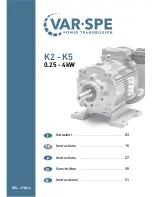
The Light Weight Engine Houtekietstraat 11
B-8540 Deerlijk, Belgium
EFFECTIVITY
page 36
ALL
19-3-2019
Preservation of the engine for long term storage
If the engine is not used for long periods and/or in extreme climatic conditions, we recommend
the following instructions to protect against corrosion. Extra protection against corrosion beyond
these recommendations is not necessary.
1.
Change the engine oil in accordance with the section in this manual
2.
Blank all openings, the exhaust tubes, the breather tube and air filters. Place in a
large heavy duty plastic bag with a minimum of 4KG of desiccant bags. Take care
not to puncture the plastic storage bag.
Using a vacuum cleaner, draw all the air out of the storage bag and seal the neck
of the bag by gathering the neck, folding it back on itself and clamping with a
large ty-wrap. Re-activate the desiccant bags at least once a year by placing in a
warm oven at 100 deg c (212 F) for several hours.
Bringing the engine back operation
1.
Remove all the protective measures
2.
Check oil level
3.
Check water level
4.
Check all connectors (from ECU to connector on engine, and from connector on
engine to all sensors, injection tubes, ignition coils, map and angle sensor(s)
5.
Check battery
An engine awaiting overhaul or return to service after overhaul must be given careful attention. It
does not receive the daily care and attention necessary to detect and correct early stages of
corrosion. For this reason, some definite action must be taken to prevent corrosion from affecting
the engine. Engines that are not flown regularly may not achieve normal service life because of
corrosion in and around the cylinders. The normal combustion process creates moisture and
corrosive by-products that attack the unprotected surfaces of the cylinder walls, valves, and any
other exposed areas that are unprotected.
In engines that have accumulated 50 hours or more time in service in a short period, the cylinder
walls have acquired a varnish that tends to protect them from corrosive action; engines under
favorable atmospheric conditions can remain inactive for several weeks without evidence of damage
by corrosion. This is the best-case scenario, but aircraft that operate close to oceans, lakes, rivers,
and humid regions have a greater need for engine preservation than engines operated in dry low
humid areas.
CAUTION!
For longer storage periods, the preservation procedures must be
performed at least annually.













































